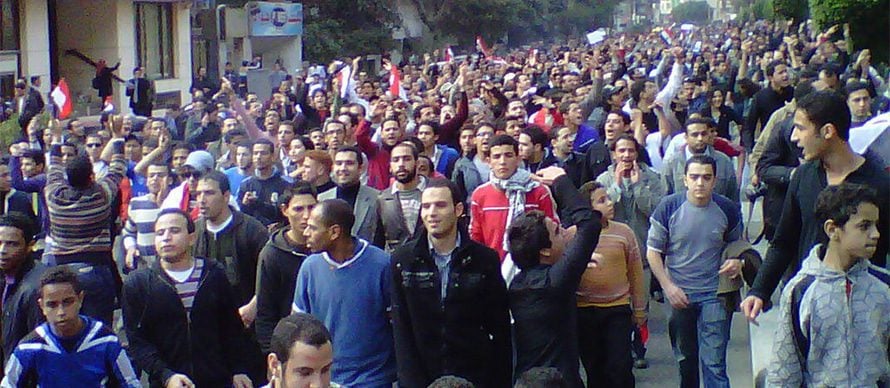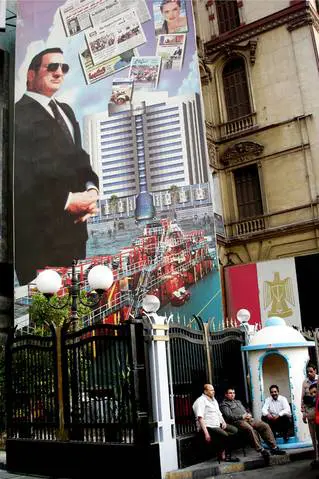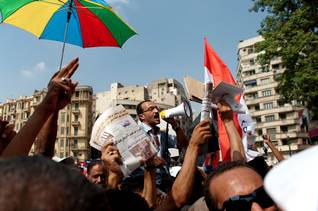
Introduction
Many factors created discontent with Mubarak’s regime. The changes in economic policy and the partial liberalization of the economy, even though they did improve annual GDP growth, were highly unpopular, particularly because most benefits of this growth were reaped by a small group of businessmen close to the government. The soaring inflation was wearing people down, as was the blatant corruption in government, which reached a peak during the 2010 elections.
Police brutality had come to light because of videos leaked on YouTube of policemen torturing suspects and the famous case of the beating to death by police of Alexandrian youth Khaled Saeed; the police justified their action by accusing him, after his death, of being a drug dealer. Sectarian riots turned particularly violent after the terrorist attack on the Church of the Two Holy Saints in Alexandria on New Year’s Eve 2010-2011; there was a growing sense that security forces had a hand in the event as a means to justify the continuation of the state of emergency.
Matters were aggravated by Mubarak’s attempt to hand power to his son Gamal, a wealthy businessman of dubious reputation, and, as assistant secretary-general of the ruling NDP and head of the party’s Policies Secretariat, already strongly positioned in the regime. The on-going demonstrations of the Kefaya (Enough) movement and later the 6 April Movement, as well as strikes in the textile industry, particularly in the city of al-Mahalla al-Kubra, are also considered to have been driving forces behind the revolution, as is the support of these demonstrations by other, mainly leftist, factions. And there was the inspiration of the successful uprising that had brought down the regime of Zine al-Abidine Ben Ali (born 1936) in Tunisia.
Egyptian Revolution | Cairo, January 25th 2011
The revolution started on Police Day, a public holiday, 25 January 2011, with a series of peaceful demonstrations in Cairo that were originally meant to draw attention to police brutality. Soon the demonstrations grew into a mass protest against the government by people of all walks of life, in Cairo and in other major cities in Egypt, most notably Alexandria and Suez City, where protests were so fierce that the city turned into a burning battlefield by 27 January.
The demands of the protestors grew bolder as the main chants became ‘bread, freedom, social justice’ and ‘the people demand the fall of the regime’. The police and Interior Ministry forces used unprecedentedly brutal force throughout the following days, particularly on 28 January, which came to be known as ‘The Friday of Anger’. The Republican Guard and the army were brought in during the night of January 28, and more fighting occurred that night.
As the protesters seized control of Tahrir Square in Cairo and proceeded to demand the removal of Mubarak, the president made previously unimagined concessions in an attempt to remain in office. He dissolved Parliament and appointed Omar Suleiman, the head of the security services, as his vice-president. None of these concessions appeased the demonstrators, and the army was unable to decide what course to follow.
The army did not intervene, for example, when the demonstrators were once again brutally attacked, this time by police in plain clothes and government-paid thugs (baltagiyaa) on 2 February in what is now called ‘The Battle of the Camel’ (so named after the government-paid thugs from among the camel riders usually working around the pyramid area who participated in the attack).
After Mubarak’s speeches appeared only to anger the crowds further, and talks with opposition figures led to nothing, the Supreme Council for the Armed Forces (SCAF) made its first statement on 10 February, making clear that the military had taken over. After eighteen days of growing demonstrations, President Mubarak (83) announced on 11 February 2011 that he would, after thirty years in office, step back and hand power to the SCAF. It was another major victory in what became known as ‘The Arab Spring’, the popular revolts against authoritarian rule in several Arab countries.





